Skip to content

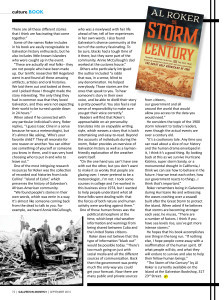
Here is an interview I did with Al Roker about his new book, “The Storm of the Century.” It deals with the devastating 1900 hurricane in Galveston, which still stands as this nation’s worst national disaster.
Mr. Roker utilized the services of a professional researcher for this project.
As someone well-versed with Galveston history, there are some things in the book that grate on my nerves, such as mislabeling the Bishop’s Palace (one of the island’s most loved architectural treasures) as Ashton Villa (another historic home), and stating that Indianola (which was completely obliterated by a hurricane) was in Mississippi (it was in Texas). I would dearly have hoped that a professional researcher or publisher fact-checker would have caught things like this.
Aside from that, Roker and his team have gathered some heart-wrenching stories about those who did and didn’t survive the storm, and the book makes a quick and interesting read.
If you read “The Storm of the Century,” let me know what you think!
Today is the 115th Anniversary of the tragic 1900 hurricane in Galveston, that took thousands of lives. I thought it was only proper for today’s post to pay tribute to a veteran who lost his life in that storm.
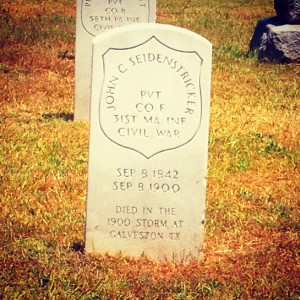
Johann “John” Karl “Charles” Seidenstricker was an immigrant who proved his allegiance and dedication to his new country soon after his arrival.
Born on September 7, 1842 in Bad Duerkeim, Pfalz, Bayern, Germany, Johann immigrated to America by himself when he was only 18 years old. He arrived in New Orleans aboard the ship Kate Dyer on February 4, 1861, just two months before the Civil War began.
He served as a private in Company F of the 31st Massachusetts Infantry, while they were stationed in Donaldsonville, Louisiana south of Baton Rouge. In December, joined by companies from nearby Fort Pike, the unit was armed and equipped as cavalry and stationed at Carrollton.
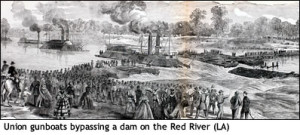 From there, Johann took part in the Red River campaign and was engaged with loss at Sabine Cross Road on April 4, 1864. He re-enlisted during the winter and left on July 21 for furlough in Massachusetts, returning to Donaldsonville in November.
From there, Johann took part in the Red River campaign and was engaged with loss at Sabine Cross Road on April 4, 1864. He re-enlisted during the winter and left on July 21 for furlough in Massachusetts, returning to Donaldsonville in November.
The regiment took part in the operations against Mobile, Alabama and occupied the city after the surrender. Johann remained on duty there until he mustered out on July 31, 1865.
Johann was naturalized in New Orleans on April 30, 1866, no doubt largely in thanks to his service to the country during the war.
 While in New Orleans he met NOLA native Married Elenora Johanna Phillippi (1842-1906). They married on September 10, 1866 at St. Matthew’s Evangelical Church in Carrollton, Louisiana.
While in New Orleans he met NOLA native Married Elenora Johanna Phillippi (1842-1906). They married on September 10, 1866 at St. Matthew’s Evangelical Church in Carrollton, Louisiana.
Johann, now known by his Anglicized name John, and his wife moved to Galveston, and raised a large family, which included Charles Louis “Carl Ludwig” (1868-1925), Elenora Johanna (1869-1962), Emma (1872-1958), Anna Elizabeth (1874-1945), Bertha (1876-1946), Frederick Godfred (1878-1946), Henry William (1881-1952), and Maude Louise (1883-1953).
He became an active member of the community, and was eventually elected a trustee of Knights of Honor’s Goethe Lodge No. 2976, one of two lodges of this fraternal beneficiary society in the city.
From 1888-1891, John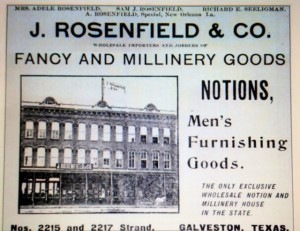 worked as a porter for Rosenfield and Co.
worked as a porter for Rosenfield and Co.
The building where he worked is now part of the historic Strand shopping district, on the second floor above Head to Footsies, The Admiralty and the Rocky Mountain Chocolate Factory.
In 1900, the couple and four of their children (Bertha, Frederick, Henry and Maude) lived together at 1209 Avenue N, very close to what is now Stewart’s Beach.
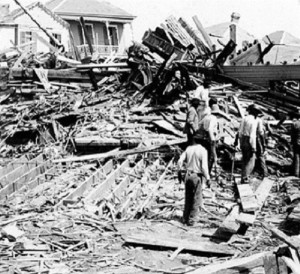 On September 8, 1900 a hurricane which is still the nation’s worst natural disaster struck the city, smashing buildings and killing thousands of people. John was one of those lost in the tragedy. It was the day after his birthday.
On September 8, 1900 a hurricane which is still the nation’s worst natural disaster struck the city, smashing buildings and killing thousands of people. John was one of those lost in the tragedy. It was the day after his birthday.
Because of the debris, bodies were found for months, and even years, after the storm. With John missing, I can only imagine his family checking the listings of identified bodies found each day in the local newspaper…praying for an answer.
John’s body was eventually discovered and identified by his son Charles. He was buried on Oct. 20, 1900 in Galveston’s Lakeview Cemetery.
Johanna died November 10, 1906 at her home at 1202 Church Street at the age of 54. She is buried at Lakeview as well.
 From there, Johann took part in the Red River campaign and was engaged with loss at Sabine Cross Road on April 4, 1864. He re-enlisted during the winter and left on July 21 for furlough in Massachusetts, returning to Donaldsonville in November.
From there, Johann took part in the Red River campaign and was engaged with loss at Sabine Cross Road on April 4, 1864. He re-enlisted during the winter and left on July 21 for furlough in Massachusetts, returning to Donaldsonville in November. While in New Orleans he met NOLA native Married Elenora Johanna Phillippi (1842-1906). They married on September 10, 1866 at St. Matthew’s Evangelical Church in Carrollton, Louisiana.
While in New Orleans he met NOLA native Married Elenora Johanna Phillippi (1842-1906). They married on September 10, 1866 at St. Matthew’s Evangelical Church in Carrollton, Louisiana. worked as a porter for Rosenfield and Co.
worked as a porter for Rosenfield and Co. On September 8, 1900 a hurricane which is still the nation’s worst natural disaster struck the city, smashing buildings and killing thousands of people. John was one of those lost in the tragedy. It was the day after his birthday.
On September 8, 1900 a hurricane which is still the nation’s worst natural disaster struck the city, smashing buildings and killing thousands of people. John was one of those lost in the tragedy. It was the day after his birthday.


